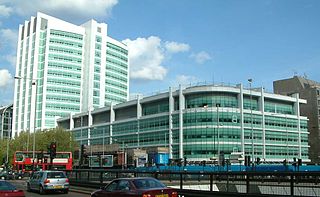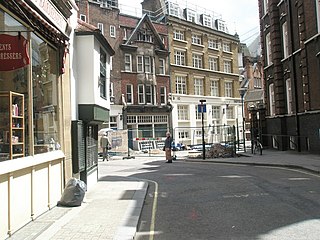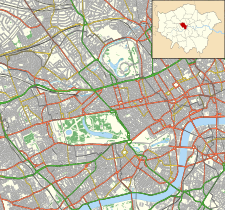"St. James Infirmary" is an American blues and jazz standard that emerged, like many others, from folk traditions. Louis Armstrong brought the song to lasting fame through his 1928 recording, on which Don Redman is named as composer; later releases credit "Joe Primrose", a pseudonym used by musician manager, music promoter and publisher Irving Mills. The melody is eight bars long, unlike songs in the classic blues genre, where there are 12 bars. It is in a minor key, and has a 4
4 time signature, but has also been played in 3
4.

University College Hospital (UCH) is a teaching hospital in the Fitzrovia area of the London Borough of Camden, England. The hospital, which was founded as the North London Hospital in 1834, is closely associated with University College London (UCL), whose main campus is situated next door. The hospital is part of the University College London Hospitals NHS Foundation Trust.

Whittington Hospital is a district general and teaching hospital of UCL Medical School and Middlesex University School of Health and Social Sciences. Located in Upper Holloway, it is managed by Whittington Health NHS Trust, operating as Whittington Health, an integrated care organisation providing hospital and community health services in the north London boroughs of Islington and Haringey. Its Jenner Building, a former smallpox hospital, is a Grade II listed building.

The National Hospital for Neurology and Neurosurgery is a neurological hospital in Queen Square, London. It is part of the University College London Hospitals NHS Foundation Trust. It was the first hospital to be established in England dedicated exclusively to treating the diseases of the nervous system. It is closely associated with University College London (UCL) and in partnership with the UCL Institute of Neurology, which occupies the same site, is a major centre for neuroscience research.

The Royal Free Hospital is a major teaching hospital in the Hampstead area of the London Borough of Camden. The hospital is part of the Royal Free London NHS Foundation Trust, which also runs services at Barnet Hospital, Chase Farm Hospital and a number of other sites. The trust is a founder member of the UCLPartners academic health science centre.

Saint Mary's Hospital is a hospital in Manchester, England. It is part of Manchester University NHS Foundation Trust. Founded in 1790, St Mary's provides a range of inter-related services specifically for women and children. In 1986, St Mary's Sexual Assault Referral Centre was the first sexual assault referral centre (SARC) to open in the UK.

The Contagious Diseases Acts were originally passed by the Parliament of the United Kingdom in 1864, with alterations and additions made in 1866 and 1869. In 1862, a committee had been established to inquire into venereal disease in the armed forces. On the committee's recommendation the first Contagious Diseases Act was passed. The legislation allowed police officers to arrest women suspected of being prostitutes in certain ports and army towns. Since there was no set definition of prostitution within the Act, the question was left to the police officer’s discretion, and women could be arrested even if there was no actual evidence of prostitution. The women were then subjected to compulsory physical examinations for venereal disease. If a woman was declared to be infected, she would be confined in what was known as a lock hospital until she recovered or her sentence was completed. Men suspected of frequenting prostitutes were not subjected to the same treatment of compulsory checks and confinement. The law was initially aimed at working-class women in towns near military bases, due to the concern that sexually transmitted infections were hampering Britain’s forces. The original act only applied to a few selected naval ports and army towns, but by 1869 the acts had been extended to cover eighteen "subjected districts".

The University Hospital Geelong, formerly the Geelong Hospital, is an Australian public hospital located in Ryrie Street, Geelong, Victoria. The hospital is part of Barwon Health, Victoria's largest regional health care provider, which has 21 sites. It is the largest hospital in regional Victoria and the only tertiary hospital outside of the Melbourne Metropolitan area. The site is bounded by Ryrie, Bellarine, Myers, and Swanston Streets.

Tsan Yuk Hospital is maternity hospital is located on 30 Hospital Road, Sai Ying Pun on Hong Kong Island, is a public hospital in Hong Kong, It was specialising in obstetrics and gynaecology. It also operates as a teaching and training hospital for the medical and nursing students of Li Ka Shing Faculty of Medicine of the University of Hong Kong.

Mount Vernon Hospital is a hospital located in Northwood in the London Borough of Hillingdon. It is one of two hospitals run by The Hillingdon Hospitals NHS Foundation Trust, the other being Hillingdon Hospital.
Jack Suchet was an English consultant obstetrician and gynaecologist, who carried out research on the use of penicillin in the treatment of venereal disease with Sir Alexander Fleming in London. He was the father of television news journalist John Suchet and actor David Suchet.
University College London Hospitals NHS Foundation Trust (UCLH) is an NHS foundation trust based in London, United Kingdom. It comprises University College Hospital, University College Hospital at Westmoreland Street, the UCH Macmillan Cancer Centre, the Royal National ENT and Eastman Dental Hospitals, the Hospital for Tropical Diseases, the National Hospital for Neurology and Neurosurgery, the Royal London Hospital for Integrated Medicine and the Royal National Throat, Nose and Ear Hospital.

The Westmoreland Lock Hospital was a hospital for venereal disease originally located at Donnybrook and later moved to Lazar's Hill, Dublin, Ireland.

University College Hospital at Westmoreland Street, named The Heart Hospital until refurbished and renamed in 2015, was a specialist cardiac hospital located in London, United Kingdom until 2015. It is part of the University College London Hospitals NHS Foundation Trust and is closely associated with University College London (UCL). After the 2015 refurbishment, the hospital now provides thoracic surgery and urology services.

A lock hospital was an establishment that specialised in treating sexually transmitted diseases. They operated in Britain and its colonies and territories from the 18th century to the 20th.

William Bromfeild (1712–1792) was an English surgeon.

The Glasgow Magdalene Institution was an asylum in Glasgow, Scotland, initially started in 1812 and was open until 1958.
Esther Rickards was a British surgeon and politician.

St Philip's Hospital was a medical facility on Sheffield Street in London, originally formed on the site of the Bear Yard Infirmary.
Caterina Scappi was a rich and well-respected benefactor of the Carmelite church in Malta. Little is known about her origins or early life, but she is known for her substantial charitable donations for women's causes. In particular, she founded the first hospital in Malta dedicated exclusively to women.
















